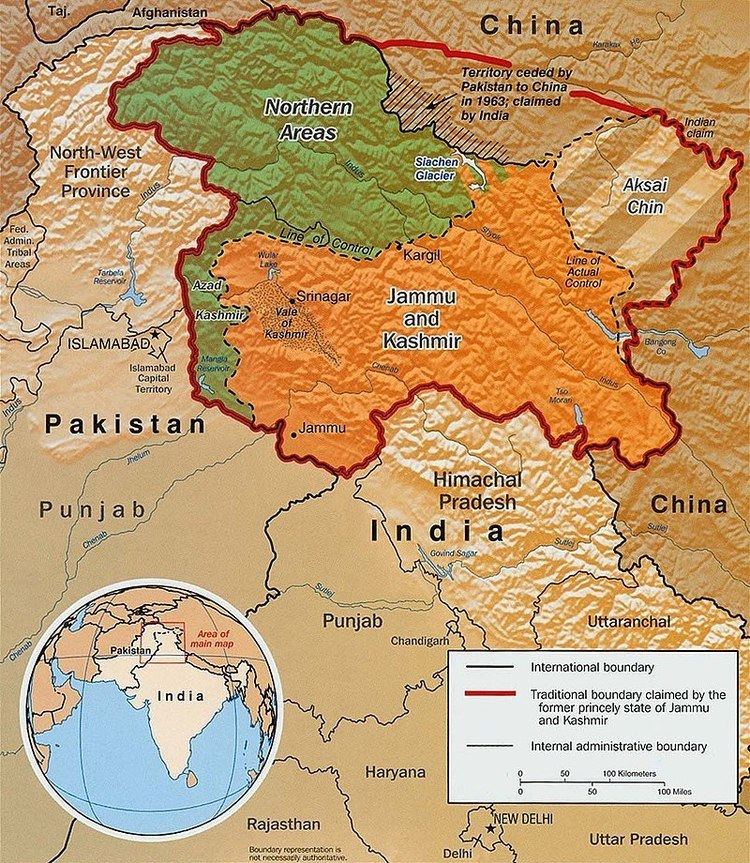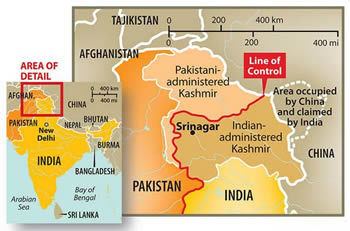 | ||
Defending the line of control at kashmir indian army part 1
The term Line of Control (LoC) refers to the military control line between the Indian and Pakistani controlled parts of the former princely state of Jammu and Kashmir—a line which does not constitute a legally recognized international boundary, but is the de facto border. Originally known as the Cease-fire Line, it was redesignated as the "Line of Control" following the Simla Agreement, which was signed on 3 July 1972. The part of the former princely state that is under Indian control is known as the state of Jammu and Kashmir. The Pakistani-controlled part is divided into Azad Jammu and Kashmir and Gilgit–Baltistan. The northernmost point of the Line of Control is known as NJ9842.
Contents
- Defending the line of control at kashmir indian army part 1
- Pak army gives terrific response to firing at line of control
- Legacy
- Pakistani
- Indian
- Indian Line of Control fencing
- References
Another ceasefire line separates the Indian-controlled state of Jammu and Kashmir from the Chinese-controlled area known as Aksai Chin. Lying further to the east, it is known as the Line of Actual Control (LAC) and has been referred to as one of the most dangerous places in the world.

Pak army gives terrific response to firing at line of control
Legacy

The Line of Control divided Kashmir into two parts and closed the Jehlum valley route, the only entrance and exit of the Kashmir Valley at that time. This territorial division, which to this day still exists, severed many villages and separated family members from each other.
Pakistani

The Pakistan Declaration of 1933 had envisioned the princely state of Jammu and Kashmir as one of the "five Northern units of India" that were to form the new nation of Pakistan, on the basis of its Muslim majority. Pakistan still claims the whole of Kashmir as its own territory, including Indian-controlled Kashmir. India has a different perspective on this interpretation.
Indian

Maharaja Hari Singh, King of the princely state of Kashmir and Jammu agreed to Governor-General Mountbatten's suggestion to sign the Instrument of Accession India demanded accession in return for assistance. India claimed that the whole territory of the princely state of Jammu and Kashmir had become Indian territory (India's official posture) due to the accession, it claims the whole region, including Azad Kashmir territory, as its own.
Indian Line of Control fencing
The Indian Line of Control fencing is a 550 km (340 mi) barrier along the 740 km (460 mi) disputed 1972 Line of Control (or ceasefire line). The fence, constructed by India, generally remains about 150 yards on the Indian-controlled side. Its stated purpose is to exclude arms smuggling and infiltration by Pakistani-based separatist militants.
The barrier itself consists of double-row of fencing and concertina wire eight to twelve feet (2.4–3.7 m) in height, and is electrified and connected to a network of motion sensors, thermal imaging devices, lighting systems and alarms. They act as "fast alert signals" to the Indian troops who can be alerted and ambush the infiltrators trying to sneak in. The small stretch of land between the rows of fencing is mined with thousands of landmines.
The construction of the barrier was begun in the 1990s, but slowed in the early 2000s as hostilities between India and Pakistan increased. After a November 2003 ceasefire agreement, building resumed and was completed in late 2004. LoC fencing was completed in Kashmir Valley and Jammu region on 30 September 2004. According to Indian military sources, the fence has reduced the numbers of militants who routinely cross into the Indian side of the disputed state to attack soldiers by 80%.
Pakistan has criticised the construction of the barrier, saying it violates both bilateral accords and relevant United Nations resolutions on the region. The European Union has supported India's stand calling the fencing as "improvement in technical means to control terrorists infiltration" and also pointing that the "Line of Control has been delineated in accordance with the 1972 Shimla agreement".
